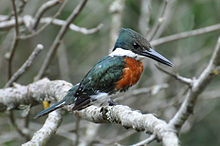- Green Kingfisher
-
Green Kingfisher 
Male in Rio Grande do Sul, Brazil Conservation status Scientific classification Kingdom: Animalia Phylum: Chordata Class: Aves Order: Coraciiformes Family: Cerylidae Genus: Chloroceryle Species: C. americana Binomial name Chloroceryle americana
(Gmelin, 1788)Subspecies C. a. americana
C. a. mathewsii
C. a. hachisukai
C. a. septentrionalis
C. a. cabanisiiThe Green Kingfisher, Chloroceryle americana, is a resident breeding bird which occurs from southern Texas in the USA south through Central and South Americal to central Argentina.
This small kingfisher breeds by streams in forests or mangroves. The nest is in a horizontal tunnel up to a metre long made in a river bank. The female lays three, sometimes four, eggs.
The Green Kingfisher is 19 centimetres (7.5 in) long and weighs 27 grams (0.95 oz). It has the typical kingfisher shape, with a short tail and long bill. It is oily green above, with white markings on the wings and tail, and a white collar around the neck.
Males have white underparts apart from a broad chestnut breast band and some green spotting on the flanks. Females have buff-white underparts with two green chest bands, the lower of which links to the green spotting along the sides of the belly.
Green Kingfishers are often seen perched on a low shaded branch close to water before plunging in head first after their fish prey. They also eat aquatic insects. These birds often give a pebbly rattling call.
Contents
Taxonomy
Variation in this species is clinal. There are five subspecies:[2]
- americana occupying northern South America east of the Andes, south to Bolivia and Brazil
- mathewsii occupying the area south of americana, to north Argentina
- hachisukai occurring from the southwestern United States to Mexico, where it merges into the next subspecies
- septentrionalis occurring from Mexico to Venezuela, where it merges with americana
- cabanisii occurring in north Chile and Peru into west Ecuador and Colombia, where it merges with americana
Birds occurring on Trinidad and Tobago, usually included in americana, have a larger and heavier bill than the mainland forms, and are sometimes separated as subspecies croteta.[3]
Gallery
-
Female in Tortuguero, Costa Rica
References
- ^ BirdLife International (2008). Chloroceryle americana. In: IUCN 2008. IUCN Red List of Threatened Species. Downloaded on 13 May 2010.
- ^ Fry, C Hilary; Fry, Kathie; Harris, Alan (1992). Kingfishers, bee-eaters and rollers. London: Christopher Helm. pp. 226–8. ISBN 0-7136-8028-8.
- ^ ffrench, Richard (1991). A Guide to the Birds of Trinidad and Tobago (2nd edition ed.). London: Christopher Helm. p. 239. ISBN 0-7136-3518-5.
- Hilty, Steven L (2003). Birds of Venezuela. London: Christopher Helm. ISBN 0-7136-6418-5.
External links
- Green Kingfisher videos on the Internet Bird Collection
- USGS
- Stamps (for El Salvador, Mexico, Nicaragua, Paraguay, Suriname) with RangeMap
- Green Kingfisher photo gallery VIREO
- Photo-High Res; Article geometer—"Brazil Photos"
Categories:- IUCN Red List least concern species
- Chloroceryle
- Birds of the United States
- Native birds of the Southwestern United States
- Fauna of the U.S. Rio Grande Valleys
- Birds of the U.S. Rio Grande Valleys
- Birds of South America
- Birds of the Amazon Basin
- Birds of the Guianas
- Birds of the Cerrado
- Birds of the Caatinga
- Birds of the Pantanal
- Birds of Argentina
- Birds of Central America
- Birds of the Yucatán Peninsula region
- Birds of Mexico
Wikimedia Foundation. 2010.






